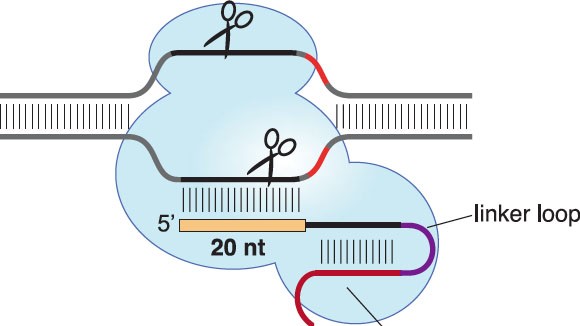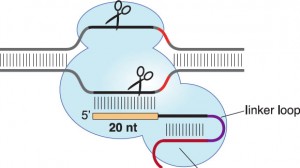From Biology to Technology
Synbio Consulting's Blog

Synthetic Biology Weekly Mashup – 9/12/2013
McDonald’s, the world’s biggest buyer of potatoes is being criticised by the advocacy group Food & Watch, backed by several NGOs, for buying genetically engineered potatoes from J. R. Simplot Co. This new potatoes variety, branded as innate by Simplot, diminishes black spots from bruising which lead a potato to go to waste and reduces the levels of the amino acid asparagine that can become a carcinogen at high temperatures, so has both environmental and health benefits. NGOs claim that altering the plant’s genes using RNA interference could ultimately affect the human health, as this technique is according to them not well understood and lacks an effective safety assessment. This new debate over innate potatoes comes at a pivotal moment in the US where States must decide over mandatory labelling of GMO food.
A research group from the University of Illinois, published in Nature Communications this week a novel DNA editing method to investigate the function of bacterial hidden genes. So far, genes functions have been mostly extrapolated from analysing the proteins they produce. However this technic vastly reduces biological complexity as many genes do not produce proteins and protein production is adapted to the environment sensed by bacteria. This allows them to save energy, but makes it challenging for scientist to unlock cryptic or silent pathways. Instead of trying to manipulate the environment, a laborious and time consuming technique, the team led by Prof Huimin Zhao directed their efforts on the regulation of gene expression using synthetic biology tools. Using a DNA assembler they were able to construct different versions of pathways, each with a specific gene deletion in order to identify which protein does what. Adding promoters between each cryptic gene cluster in a soil bacterium allowed them to control the expression of the genes, and increase it. The team discovered three previously unknown compounds with useful biomedical applications.
23andMe Stops Providing Genetic Health Reports
On Thursday, the personal genetics company 23andMe, announced that it would only provide raw genetic data and ancestry reports, and stop health reports for new customers. It offers a full refund for customers that purchased their kit after the 22nd of November and has stopped updating the health reports for the existing customers. This is two weeks after the US Food and Drug Administration asked the company to stop marketing its genetic kits, for regulation issues and the possible problem associated with people taking action based on the results provided by the kits (see our last newsletter). While there is no denying that the case has not been handled the best way by 23andMe, it has highlighted the need for an update on regulations, which were last revised in 1976 before genetic tests even existed.
The Enerbio fund was created by the Tuck Foundation to finance research projects geared primarily toward identifying and fostering the emergence of innovative, competitive methods for using biomass for biofuels and bioproducts. The fund was financed by industrial partners Axens, Diester Industrie (Sofiproteol), Renault and Total and has been instrumental in the development of Synthetic Biology research projects exploring the use of biomass for biofuel production all around Europe as early as 2005.

Synthetic Biology Weekly Mashup – 1/12/2013
CRISPR Method Altered for Genetic Regulation by the Synthetic Biology Group at MIT
MIT researchers have shown that they can turn genes on/off inside yeast and human cells by controlling when DNA is copied into messenger RNA (mRNA). The new method published in the latest issue of ACS Synthetic Biology is based on a system of viral proteins that can edit the genomes of bacterial and human cells, called CRISPR. CRISPR has been used in the past to cut pieces of a gene to disable it or replace it with a new gene. Timothy Lu and his team used the CRISPR system to control gene transcription, by changing it to act as a transcription factor, and discovered that it can both positively and negatively impact transcription. Furthermore, they incorporated a transcription-control system initiated by the addition of small sugars. This should not only allow a better understanding of the function of individual genes, but also make it easier to engineer cells that can monitor their environment, produce drugs or detect disease in eukaryotic cells.
New Synbio Startup Focusses on Regenerative Medicine
A new biotech startup based in Frederick, Maryland, USA, RoosterBio Inc., is building a new synthetic biology regenerative medicine platform. Regenerative medicine refers to the medical therapies that will allow the body to repair, replace and restore damaged or diseased cells. This field has advanced slowly due to the high cost of living cells and the small size of samples currently available for research. RoosterBio aim is to manufacture large quantities of high quality standardized primary cells at low cost, which will lead to the minimisation of unexplained cellular events and will help innovations get out of labs into the clinics. The official product launch is expected in March 2014 for human bone marrow-derived Mesenchymal Stem Cells.
A new synthetic biology research project is to be undertaken in Arizona State University. The effort led by Karmella Haynes will be focusing on treatments for diabetes, a disease projected to afflict 300 million people worldwide by 2025 according to the WHO. Dr. Haynes will grow pancreatic cells in an artificial culture that will enable her to look at them in a three-dimensional view. The pancreas regulates blood sugar level happens through two different hormones. The lab will be designing synthetic proteins capable of tracking changes in the DNA of the pancreatic cells allowing to manipulate the state of cells and to maintain healthy pancreatic tissue.
23andMe Personal Genetic Test vs FDA
This week, the Food and Drug Administration (FDA) asked the 2006-founded start-up company 23andMe to stop selling all of its products. Google-backed 23andMe operates by doing personal genetic code reading using small saliva samples from its customers collected via a small kit sent at home currently retailing $99. Results predicts the potential development of a range of disease based on literature evidence and provides genealogy information. The company failed to give the FDA with proof on the accuracy of their methods, despite a long period of communication. As of today, 23andMe is still selling their kits online and has only addressed the issue through a short statement pointing to scheduling and organisation issues. If you want to read more, we recommend interesting article published this week in the New Yorker analyzing the case.
Complex Boolean Logic Gate with Bacterial Enterotoxins Developed by University of Munich
A new article describing how bacterial toxins were used to perform Boolean logic functions was published this week in Chemical Communications . Erwin Märtlbauer and his team from the University of Munich took the AND and OR gates to a new level by using membrane protein domains to produce different combinatorial and sequential logic operators. The team used a unique enterotoxin protein made of three parts, where each part must bind in a specific order to the cell membrane to cause cell death. The obligatory sequential binding of each part of the protein insures that cell death only occurs from the right order, providing memory to the biological logic gate.
A review of iGEM projects focusing on helping development
This year has seen numerous projects trying to tackle health and medicine issues at the international Genetically Engineered Machine competition (iGEM). This week, an article in SciDevNet summarises this year’s most successful projects trying to tackle questions aiding development. In the spotlight are two Indonesian teams, one targeted tuberculosis, a disease that annually kills 175000 people in Indonesia, and the other created a biosensor for aflatoxin, a food contaminant.
Synbio Consulting has been heavily involved in fostering the use of Synthetic Biology as a tool for development through a number of projects. This article highlights once more the power of synthetic biology to address glocal issues.
That’s it for this week’s Synthetic Biology Mashup! A suggestion or a question? Shoot us an email.
Synthetic Biology Weekly Mashup – 22/11/2013
7 Myths about DIYbio by the Wilson Center
Security concerns have been raised over the emergence and expansion of Do-It-Yourself biology (DIYbio), amateur biologists working in community laboratories or, in minority, in their own houses. On Tuesday the Synthetic Biology Project at the Woodrow Wilson International Center for Scholars released a survey report suggesting most of these fears are unfounded and the field is far from the stage often portrayed in the media and by policy makers. The survey highlights what kind of the basic research is undertaken in these community labs, and most importantly the educational and innovation aspect of it, which is often not mentioned. The report is available here, and you can read more about this in Vice and the New Scientist.
Art Project on Bacterial Carpet that Cleans your Feet and Detects Toxins
Tashia Tucker explores in her latest project the applications synthetic biology could have on interior design, through the design of adaptive living environments. The project specifically explores floors embedded with synthetic bacteria that could clean your feet and eat possible spillage in the kitchen. She devised a colour-changing scheme in case of toxin detection and through this Art-Science project questions our relationship with the living.
Intrexon announced the appointment of Ms. Dana Di Ferdinando as Vice President of Business Development for Europe and Asia and Dr. Peter Seufer-Wasserthal as Chief Information Officer. An interesting move by Intrexon to develop its presence in the European and Asian markets, specifically in the Food, Health, Energy and Environment sectors and to fast-track the development of its proprietary synthetic biology platform.
This week two more project partners to the Synergene Consortium, part of the European Commission’s 7th Framework Programme for Research and Technological Development were announced: the University of Bristol in the UK, and the Synthetic Biology Project of the Woodrow Wilson International Center. They join 26 other groups European groups and one Canadian group, in an effort of the European Union to associate participants from various fields and countries in order to develop a platform for knowledge exchange and responsible governance schemes for synthetic biology. The initiative will be managed by the Karlsruhe Institute of Technology in Germany. Public awareness has been an important concern in synthetic biology, and this new initiative could help shape the landscape for a better understanding of the field.
That’s it for this week’s Synthetic Biology Mashup! A suggestion or a question? Shoot us an email.




